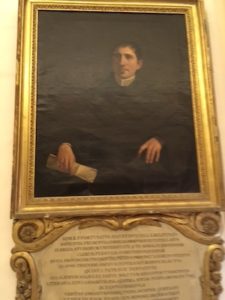When the seer is a reader
Last week’s blog concerned a painting (St Jerome sits writing), one to be looked at and seen by a seer, by someone who looks. Its subject is St Jerome writing, that is, the act of writing, and not what was written. It is to be looked at and not in the literal sense to be read: no text is visible, it is implied in a symbolic way. The topic of this week’s blog is very different.
 There is a Monastery and Church of St Augustine on Old Bakery Street, Valletta, Malta. It was re-built after an earthquake in 1763. When the Monastery – and Valletta – first started being built, the Great Siege of 1565 had ended with the religious Knights of St John et al defeating the ’infidels’ of Asia and Africa. The Monastery has an inner Gallery, which like the rest of the monastery is separate from its publicly accessible Church. On the walls of this are portraits of many of the senior figures associated with the Monastery since its late sixteenth century inception, just under 30 of them. Some of these men are holding books, more of them are holding a letter, the contents of which are clearly visible by walking before each of them, down one side and up the other. But originally, they were spread around the different parts of the Monastery.
There is a Monastery and Church of St Augustine on Old Bakery Street, Valletta, Malta. It was re-built after an earthquake in 1763. When the Monastery – and Valletta – first started being built, the Great Siege of 1565 had ended with the religious Knights of St John et al defeating the ’infidels’ of Asia and Africa. The Monastery has an inner Gallery, which like the rest of the monastery is separate from its publicly accessible Church. On the walls of this are portraits of many of the senior figures associated with the Monastery since its late sixteenth century inception, just under 30 of them. Some of these men are holding books, more of them are holding a letter, the contents of which are clearly visible by walking before each of them, down one side and up the other. But originally, they were spread around the different parts of the Monastery.

Why are there letters in the portraits? This is to show status, that in the non-reading times when the pictured were painted these men were of an order of person who read and who were written to. Ditto those shown with books. And they are all men who were associated with education. But there is more to it than this.
These letters are actual letters. They are in Latin and are easily legible, and they can be read by those who understand it. They are biographical, they tell of the person shown, more specifically they tell information about these men to the reader, including their educational and other achievements. There is most definitely an intended reader. Look, and also read.

The portraits are of course to be seen; but they are also to be read in the literal sense, and they feature letters implicitly addressed to a specific but unnamed audience of readers. And the pages of the books do likewise. It is not the ’general reader’ who is being addressed, but it is not a named person or persons either. The letters in the portraits are a representational version of a ‘public’ letter, but where this is actually intended for a tiny specialist part of ‘the public’. Imagine, for instance, arcane letters on cricket rules in the ‘Letters to the Editor’ pages of a newspaper – apparently public, though in fact actually for a specialist group.

The seer/reader is in the monastery, a sequestered place, looking at images of personified hierarchy, reading about these persons in authoritative positions and their worldly achievements. This is not the usual aesthetic now associated with monasteries, with the presumed humility of monastic order. But in past times, such an emphasis in representational form on the hierarchies within the monastic order, as well as between it and the laity, was doubtless highly prevalent.
The implied reader of these letters is a man, a member of the elite, one of the select, and separate even from the majority of those in the monastery, not to mention the mass of people. And the letter played an important role in pushing these points home.
Last updated: 14 December 2017





